As an integral part of any style of music, your role as a bass player will be to glue the band together and create a bridge between rhythm and harmony, laying down the foundations for both.
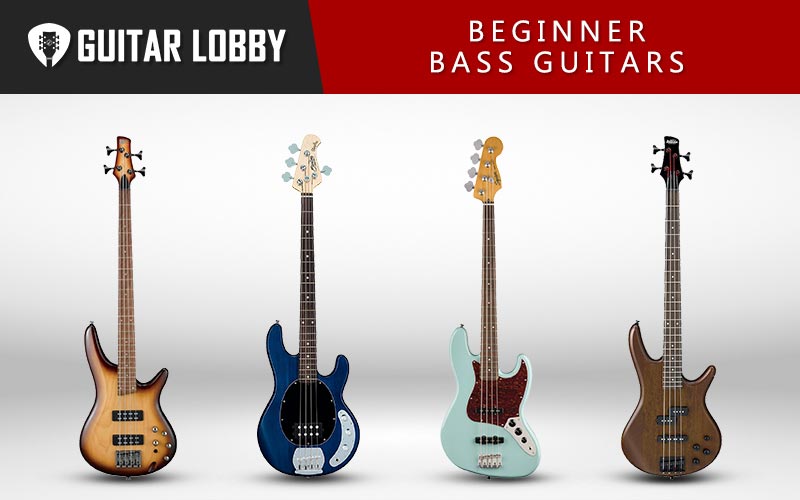
Choosing a bass guitar isn’t an easy task if you don’t know what brands and features to look for. I’ll start this guide by reviewing the best beginner bass guitars at each price point, but if you want to learn more about bass guitars before reading reviews, check out our buying guide at the bottom of the page here.
| Name of Product | Image of Product | Key Specs | Price Range | Full Review |
|---|---|---|---|---|
| 1. Squier Classic Vibe ’70s Precision (Best Overall) | 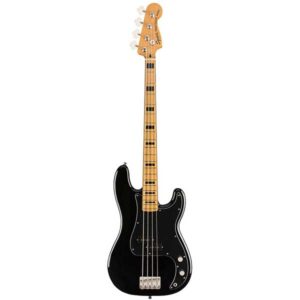 | Scale: 34″ long scale Frets: 20, narrow, tall frets | $400 | Read Full Review Below |
| 2. Ibanez GSR200B (Best Value) | 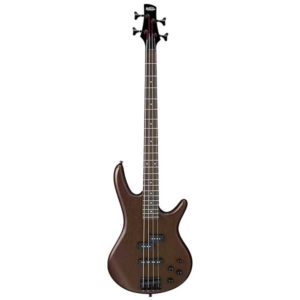 | Scale: 34″ long scale Frets: 22, medium size | $200 | Read Full Review Below |
| 3. ESP LTD B-204SM (Best Under $500) | 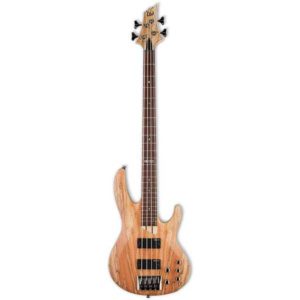 | Scale: 34” long scale Frets: 24 jumbo-sized frets | $500 | Read Full Review Below |
| 4. Sterling by MusicMan SUB Stingray 4 HH (Best Under $400) | 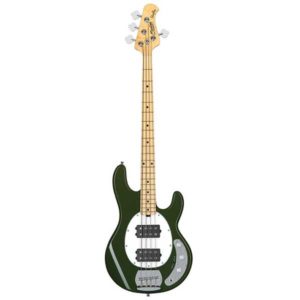 | Scale: 34″ long scale Frets: 21 high profile, stainless steel | $380 | Read Full Review Below |
| 5. Ibanez GSRM20B (Best Value) | 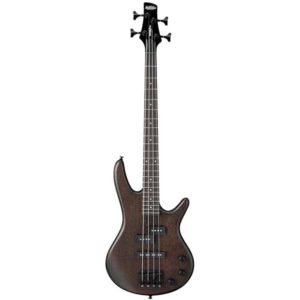 | Scale: 28.6″ short scale Frets: 22, medium size | $180 | Read Full Review Below |
| 6. Yamaha TRBX174 | 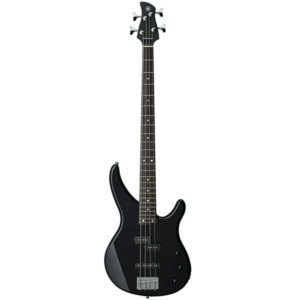 | Scale: 34″ long scale Frets: 24, medium-sized | $200 | Read Full Review Below |
| 7. Squier Classic Vibe ’60s Jazz Bass | 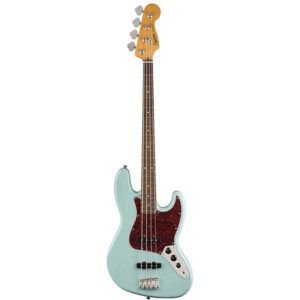 | Scale: 34″ long scale Frets: 20, narrow, tall frets | $400 | Read Full Review Below |
| 8. Ibanez SR370E | 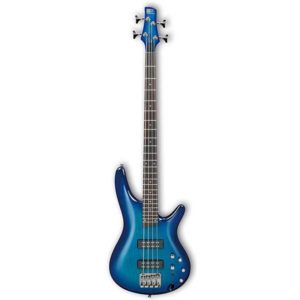 | Scale: 34″ long scale Frets: 24, medium size | $400 | Read Full Review Below |
| 9. Yamaha BB234 | 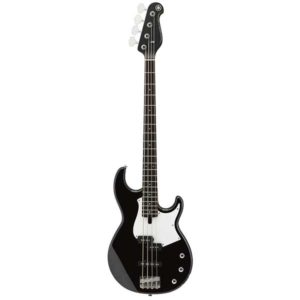 | Scale: 34″ long scale Frets: 22, Medium-sized frets | $299 | Read Full Review Below |
| 10. Jackson JS Series Spectra Bass JS3Q | 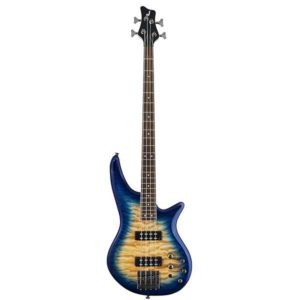 | Scale: 34″ long scale Frets: 24, Jumbo-sized | $350 | Read Full Review Below |
| 11. Dean Edge 2 | 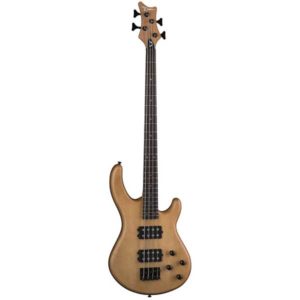 | Scale: 34″ long scale Frets: 24, medium-sized frets | $250 | Read Full Review Below |
| 12. Sire Marcus Miller P7 (2nd Gen) | 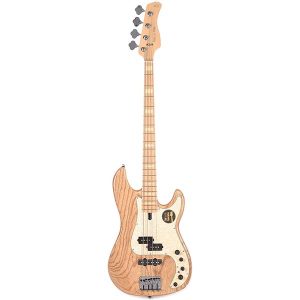 | Scale: 34” Frets: 24 Medium | $670 | Read Full Review Below |
| 13. Fender American Professional II Precision Bass | 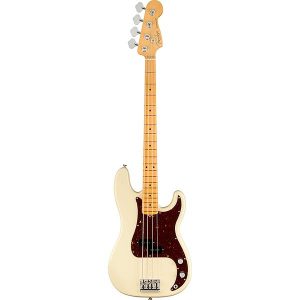 | Scale: 34” Frets: 20, narrow-tall | $1550 | Read Full Review Below |
| 14. Fender American Professional II Jazz Bass | 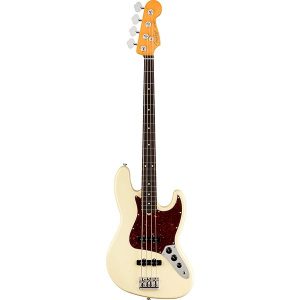 | Scale: 34” Frets: 20, narrow-tall | $1600 | Read Full Review Below |
| 15. Ibanez Soundgear Premium SR1340B | 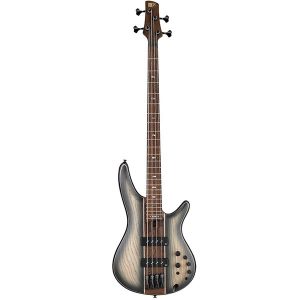 | Scale: 34” Frets: 24, medium | $1299 | Read Full Review Below |
| 16. Washburn Taurus T24NMK | 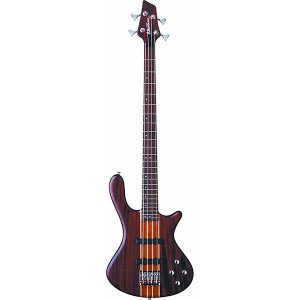 | Scale: 34” Frets: 24, medium | $650 | Read Full Review Below |
| 17. Sterling by MusicMan Stingray Ray34HH | 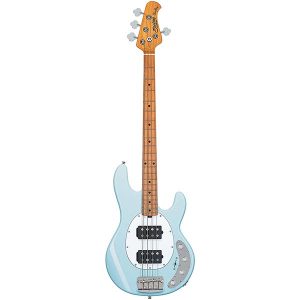 | Scale: 34” Frets: 21, wide-high profile | $900 | Read Full Review Below |
Here Are the Best Beginner Bass Guitars
1. Squier Classic Vibe 70s Precision Bass (Best Overall)
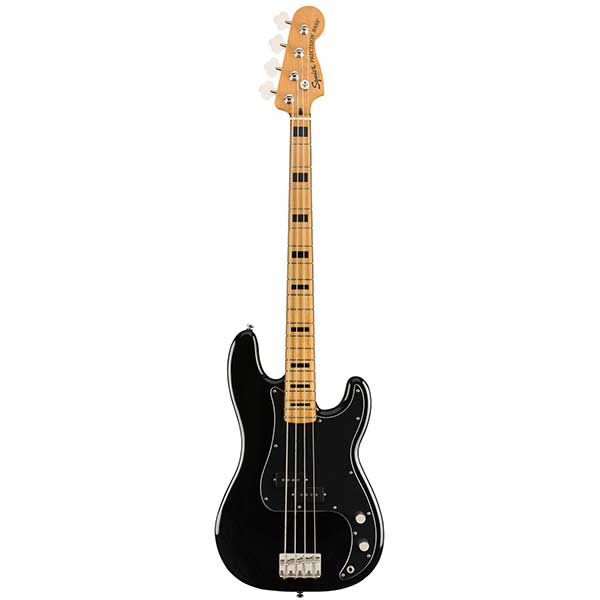
| Estimated Price | $400 |
| Scale | 34″ long scale |
| Finish | Gloss Polyurethane |
| Body material | Nato |
| Neck | Maple with Tinted Gloss Urethane |
| Fretboard material | Maple With ’70s Style black block inlays |
| Frets | 20, narrow, tall frets |
| Electronics | Passive |
| Control layout | 1 master volume, 1 passive cut only tone control |
My Review: The Squier Classic Vibe series was created as Fender’s response to the surge in the demand for vintage guitars and basses. Fender resurrected one of their all-time legends for the Squire Classic Vibe lineup: The Precision Bass in its 1970s specs. The Precision was the first electric bass to earn widespread attention from the general public, becoming one of the best-selling and most imitated bass designs in history. The “vibe” part of the name hints at the fact that this is not a reissue or recreation of a 1970s era Precision Bass, but that it is a modern instrument with certain vintage features added, altering its aesthetics, tone, or handling to more closely resemble an instrument from decades-long past- this is, in essence, a modern tribute to a 1970’s P-bass.
The body exhibits the standard Precision shape and is made from Nato which is used as a replacement tonewood for Mahogany. This will change the fundamental tone of the Vibe in ways that you might not expect from a 1970s P-bass, the latter having been built with an ash body. The Vibe has a little less pronounced low end but will make up for this with much more midrange presence than its forebearer. There are 2 color options for the Vibe ’70s P-bass: Walnut and Black.
The neck has a narrow C-shaped profile and is made from one solid piece of maple. It includes the fretboard with its ’70s style black binding, black block inlays, and the 20 narrow but tall frets. It is bolted on to the body in its reasonably precise pocket, using 4 screws and a neck plate featuring a Squier engraving. On the back of the neck, you can see the so-called “skunk-stripe” through which the truss rod has been inserted. On the headstock, you’ll find the 4 vintage-style open-backed machine heads, the bone nut, and the Squier Precision Bass logo in its 1970’s variant.
The L-shaped, vintage-style bridge with the threaded steel saddles feels appropriate for the general vibe of the instrument and offers adjustment options for intonation and string height. The hardware on both color variants comes with a nickel finish, while the control knobs and pickguard are made of black plastic with white accents.
The single, Fender-designed Split-Coil pickup with AlNiCo magnets sits in its rightful place roughly in the middle of the distance between the neck and the bridge. This is obviously a fully passive instrument, with no active preamp and EQ. The control layout features 2 knobs, a master volume, and passive tone control with a treble cut only.
It typically comes with a pretty good factory setup straight out of the box, so you can start playing comfortably the moment you take it out of its wrapping, without having to fiddle with it yourself or taking it for a check-up. The quality of the finish and detailing isn’t as spotless and precise as with non-Squier models. If you take a closer look at your bass you’ll start to see these small imperfections. Luckily they don’t influence playability so it’s not a real issue and also, complaining over minutiae at this price point borders on ungratefulness when you get an instrument as good as this one.
In some regards, the Squier Classic Vibe ’70s Precision Bass is a better instrument than basses from the ’70s ever were. Maybe with this Vibe P-bass, Fender tried to remedy some of the mistakes of the past. The addition of the Mahogany-like Nato tonewood seems to improve on the classic P-bass’ lack of well-defined midrange. If you are looking for your first bass, or second, or third, this could be the one you won’t part with. From thumping dub-like sounds to midrange-heavy tones that cut through any mix like butter – this is the Squier Classic Vibe ’70s, Precision Bass.
2. Ibanez GSR200B (Best Value)
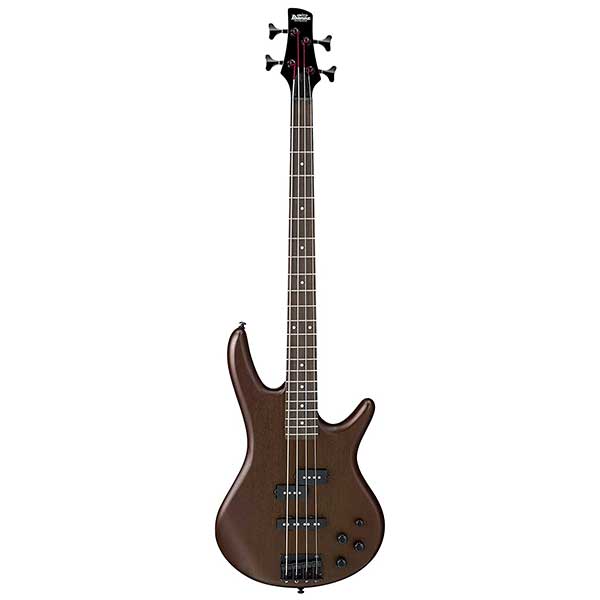
| Estimated Price | $200 |
| Scale | 34″ long scale |
| Finish | Nyatoh |
| Body material | Nyatoh |
| Neck | Bolt-on, Maple |
| Fretboard material | Jatoba with white dot fret markers |
| Frets | 22, medium size |
| Electronics | Active, Phat II bass boost, powered by a 9V block battery |
| Control layout | 2 volume knobs, 1 passive tone control, 1 Phat II bass boost |
My Review: The GSR series of basses from Ibanez was created for bass players who demand great tone and build quality but at a budget-friendly price point. It almost doesn’t make sense that Ibanez is able to turn out such a good instrument at this price point, but they do. In my opinion, it’s the best beginner bass guitar out there for the money.
The body uses Nyatoh as a tonewood. This is considered to be a more sustainable alternative to Mahogany from which the GSR200’s body was built in the past. Sonically and visually they should be indistinguishable from each other. The GSR200’s body shape is almost identical to the more prestigious SR line, though slightly less contoured than its cousin and the lower cutaway is still ideally crafted to let you reach the highest frets on its fretboard.
The 34″ long scale, bolt-on neck is built from maple with a satin finish and again, very similar to the SR series in terms of shape, feel, playability, and build quality but instead of the 24 frets you find on an SR, there are only 22 medium-sized frets set into the GSR’s fretboard, with simple white dot marker inlays – in a blind test you would be hard-pressed to tell one from the other. The fretboard is made from Jatoba, the same as the SR series, and the sound it imparts is very similar to rosewood.
It comes in two color variations: Weathered Black and Walnut Flat, both with black hardware and a black headstock. The die-cast tuning keys follow the standard Ibanez 2:2 layout. The B10 bridge is very similar to the classic L-shaped Fender bridges, though the B10 has slightly more bulk behind it and the saddles have an improved design compared to the old school classic, allowing you to set everything up as you like it.
The GSR200B has a passive P-J pickup layout, a Dynamix P style pickup in the neck position paired with a Dynamix J style pickup in the bridge position. It is obvious that Ibanez had versatility in mind while designing this bass, as the P-J is one of the most versatile pickup combinations available. But they didn’t stop there, they added the Phat II active bass boost to the GSR’s arsenal, and at its price point, an active circuit is unique indeed. There are 4 controls to experiment with: 2 volume knobs for each of the pickups, a passive, cut only tone control, and the Phat II bass boost. When adding the Phat II into the mix, you will hear a slightly scooped sound, as it boosts the lows and highs much more than it does the mids. Used together with the passive tone control you can get a wide range of very usable sounds.
The GSR200B is the ultimate beginner bass. It’s got a very fast and comfortable neck, a bright and transparent fundamental tone, an active bass boost circuit, very good build quality, and factory setup – at 200$ this is one instance where you get very much more than what you pay for. It’s available in left handed and 5 and 6-string versions called GSR205B/GSR206B with a slight price adjustment. There is also a short scale version, the GSRM20B, which you can read below by continuing down this list or by clicking here.
3. ESP LTD B-204SM (Best under $500)
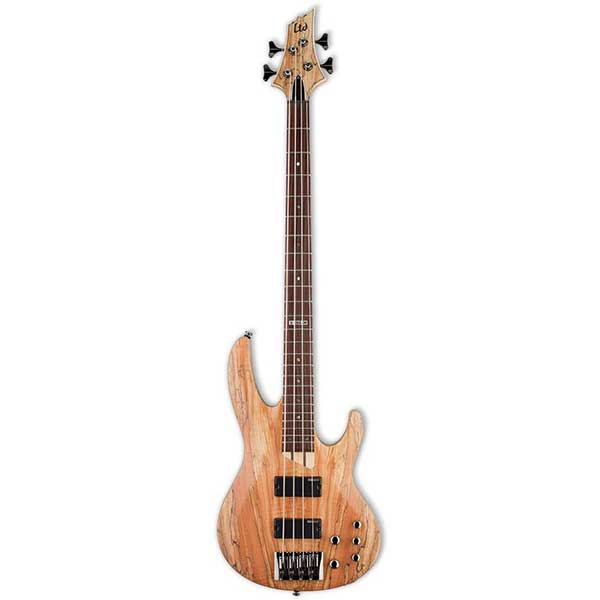
| Estimated Price | $500 |
| Scale | 34” long scale |
| Finish | Satin |
| Body material | Ash with Spalted Maple top |
| Neck | Bolt-on, thin U shaped, 5-piece laminated Maple/Jatoba |
| Fretboard material | Roasted Jatoba with Abalone dot fret markers and 12th fret “B-204SM” inlay |
| Frets | 24XJ jumbo-sized frets |
| Electronics | Active ABQ-3, 3-band EQ powered by a 9V block battery |
| Control layout | 1 Master Volume, 1 Pickup blend, 3-band EQ (1 bass, 1 mid,1 treble) |
My Review: ESP (Electronic Sound Products) started out in 1975 as a small shop providing custom replacement parts for guitars in Tokyo, Japan. In the early 80’s they expanded their business to New York and shortly after that, started crafting custom instruments for the local artists based there. Following their success as a guitar and bass manufacturer, ESP got out of the replacement parts business, focusing solely on building premium guitars and basses. In 1995 the LTD series was created to build their high-quality instruments at more affordable prices.
Enter the ESP LTD B-204SM 4-string bass (the SM stands for spalted maple). It wears its custom shop DNA on the outside for everyone to see. The delicately contoured body with its double-cutaway is made from solid ash, but the first thing that catches your eye is the beautiful spalted maple top and its matching headstock in a natural finish, an absolute rarity at its price point. The lower cutaway is generous in its size and ensures that you’ll reach the highest registers of the fretboard with ease.
The 34” long scale neck has a thin, U-shaped profile, is built from a 5-piece Maple/Jatoba laminate which bolts on to the body via 6 screws and rests in an oversized and impeccably crafted pocket inside the body.
The fretboard is made from roasted Jatoba and is sonically comparable to Rosewood. On it, you’ll find 24 XJ Jumbo frets with abalone dot inlays. Instead of the 12th fret double-dot, it has the model name (B-204SM) inlaid in abalone, which I think is kind of quirky but not an issue for me personally.
The hardware comes in a black nickel finish. The solid and hefty bridge is LTD’s own BB-604 design, allowing for both top loading and running the strings through the body, the latter method resulting in increased sustain. The LTD closed tuners are placed in a 2:2 configuration on the headstock.
The B-204SM sports a pair of LTD designed passive SB-4 humbucker pickups, actively aided by the ABQ-3, 3-band EQ with boost/cut function, powered by a 9V battery sitting in its compartment accessible from the back of the body. It has a 5-knob layout: 1 master volume, 1 pickup blend, plus 3 EQ pots for the bass, mid, and high frequencies.
By combining ash and maple in the body as tonewoods, ESP has created a bass with a strong fundamental low end imparted by the ash, while the maple component adds a well defined and clear high end. The humbuckers and 3-band EQ only enhance the B-204’s Hi-Fi sound and versatility.
The ESP LTD B-204SM is not only a beauty to look at, but also a joy to play thanks to its thin, U-shaped neck with satin finish and generous lower cutaway. Its large assortment of sounds and superior build quality make it a great choice for any level of bass player. It’s also available in 5 and 6 string versions B-205SM / B206SM
Related Article: The Best Bass Amps on the Market Right Now
4. Sterling by MusicMan SUB Stingray 4 HH (Best Under $400)
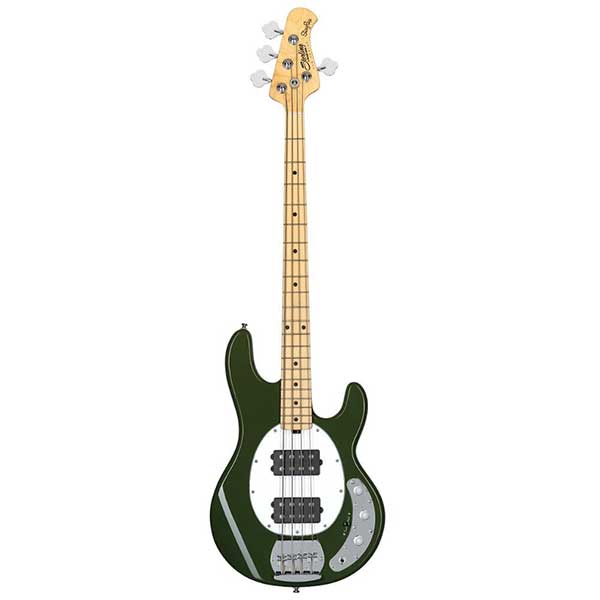
| Estimated Price | $380 |
| Scale | 34″ long scale |
| Finish | High Gloss Polyester |
| Body material | Basswood |
| Neck | Bolt-on, Hard Maple |
| Fretboard material | Maple or Jatoba |
| Frets | 21 high profile, stainless steel |
| Electronics | Active, 2-band preamp, powered by a 9V block battery |
| Control layout | Volume, bass, treble |
My Review: The MusicMan Stingray is an iconic bass guitar and its pedigree is unquestionable. Being designed in part by bass guru Leo Fender in the ’70s, and having a list of famous players as long as the now-extinct telephone book, has only added to its appeal – funk legend Louis Johnson, Colin Greenwood of Radiohead, Justin Chancellor of Tool, Joe Dart of Vulfpeck or Stefan Lessard of Dave Matthews Band, just to name a few and the list goes on and on to infinity. The Stingray’s place in history is secured as being the first commercially available bass with an on-board 9V active EQ, fit for the bass player masses, while its characteristic, aggressive growl can be traced back to the oversized humbucker placed near the bridge. After this brief bass history lesson, fast forward to the late 2000’s when finally the Sterling by MusicMan SUB series hits the market. Even though Stirling is tasked with producing affordable Stingray copies, they still have much in common with the original they are based on, in terms of build quality and performance.
The Sterling SUB series StingRay 4 HH has a Basswood body with a double cutaway in the classic Stingray fashion but slightly smaller than the original and comes with an olive, dark green finish.
The Ray4’s neck is crafted from Hard Maple and is bolted on to the body with 6 screws, it has been slimmed down a little as well, making it better suited for newcomers to the instrument. The fretboard is also made from Hard Maple, sporting 21 high profile frets with simple black dot fret markers. The headstock is of classic Stingray design, with Shaller open machine heads in a 3:1 layout. The truss rod adjustment wheel is located near the base of the neck, where it meets the body.
The MusicMan style chrome-plated, hardened steel bridge, is basic in its design and lets you adjust for intonation and action, it is slightly less massive than the original.
The SUB Ray4 is fitted with a pair of standard MusicMan humbucking pickups with ceramic magnets. These beefy, hot signaled pickups are the reason for the Stingray’s signature growl. The dual humbucker layout is connected to a 5-way pickup selector, letting you choose between the single-coils and humbuckers in various configurations, adding greatly to the tonal range of the instrument when compared to the classic, single humbucker layout.
On the back of the body, you’ll find the compartment for the electronics and a separate one housing the 9V battery which supplies power to the 2-band active preamp.
This is a solid bass with solid sounds, ranging from the aggressive bite of the original Stingray to classic J and P-bass-like tones thanks to the dual humbuckers, the coil tap switch, and the 2-band EQ. As a beginner bass guitar, the SUB Stingray4 HH exceeds all expectations and will comfortably serve even seasoned bass players for years to come.
If you don’t like the maple fretboard, there’s an alternative in a finish called Lake Blue Metallic with a Jatoba fretboard. And of course, there are variants with single humbuckers, like the original Stingray. The bottom line is for the money this is easily one of the best beginner bass guitars out there!
5. Ibanez GSRM20B (Best Short Scale Bass)
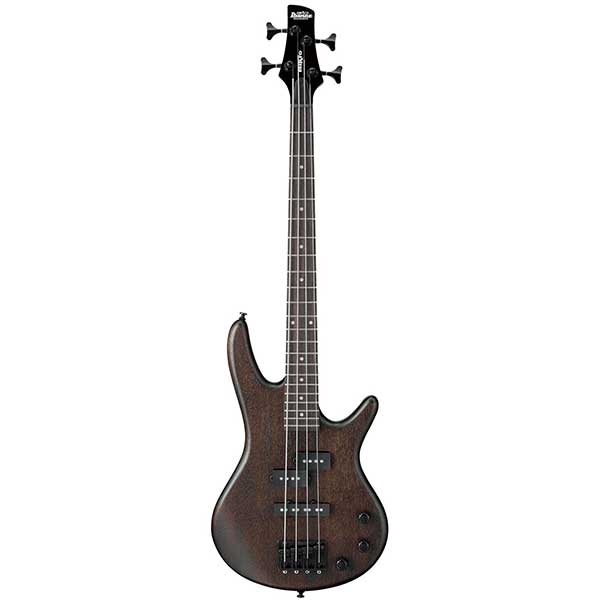
| Estimated Price | $180 |
| Scale | 28.6″ short scale |
| Finish | Gloss Polyurethane |
| Body material | Poplar |
| Neck | Bolt-on, Maple |
| Fretboard material | Jatoba with white dot fret markers |
| Frets | 22, medium size |
| Electronics | Passive |
| Control layout | 1 neck volume, 1 bridge volume 1 passive tone control |
My Review: The GSRM20B “mikro” is a 28.6″ super short-scale bass (30″ is considered the standard short scale) designed with young players in mind who would be struggling to learn to play and practice on the standard 34″ long scale basses. The short scale length and narrower frets enable small hands to acquire the proper techniques and apply them correctly without resorting to left-hand acrobatics. Despite its intended purpose as the first bass for young musicians, fully grown, standard scale bass players can have a lot of fun with the GSRM20B mikro bass, as it definitely proves that big tone doesn’t always come from big and bulky packages. The lightweight Poplar body is contoured to the standard GSR/SR template with twin cutaways through all, with reduced dimensions when compared to the mikro’s fully grown relatives. The generous bottom cutaway allows comfortable access up to the end of the fretboard. It comes with two color options: Walnut Flat and Weathered Black.
The bolt-on maple neck has a flat D shape with a satin finish, ending in a jet black headstock(like all GSR basses) with the standard Ibanez closed machine heads in a 2:2 layout.
The Jatoba fretboard is accented by simple white dot fret markers and bears 22 well finished medium-sized frets. The B10 bridge can be found on the entire GRS line of basses and it has also made its way to the “mikro”. Its design takes inspiration from the old school Fender L-shaped bridges but improves on it by beefing up its mass and string saddles. The hardware is finished in simple, straight forward black.
The “mikro” has a passive P-J pickup layout, a Dynamix P style pickup in the neck position paired with a Dynamix J style pickup in the bridge position. This pickup configuration provides great flexibility in shaping your tone, even when active electronics are not available.
This is a fully passive instrument, with a control layout comprised of double volume controls and a passive, cut only tone control. The tonal arsenal of the “mikro” is astounding, the P-style neck pickup provides fat, full-bodied, thumping bass, while the J-style bridge pickup delivers transparent, midrange, and treble-heavy sounds.
This is a bass guitar mainly directed at young players but Ibanez has outdone themselves in creating this little powerhouse. The Mikro could be an ideal bass for the traveling bassist. If you don’t want to lug your full-sized gear with you but still want to practice or even gig, this is the bass you’ll want by your side and at this price, it’s a steal. The GSRM20B is available in a 5-string variant! There is also a full-scale model, the GSRM200B, which you can read my review on this list by scrolling back up this list or by clicking here.
Popular Related Article: Our Favorite Short Scale Bass Guitars
6. Yamaha TRBX174
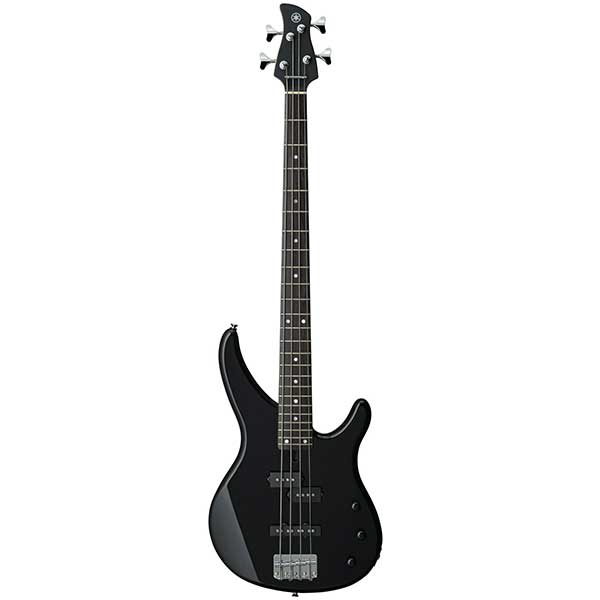
| Estimated Price | $200 |
| Scale | 34″ long scale |
| Finish | Glossy |
| Body material | Alder |
| Neck | Maple, Bolt-on, C-shape |
| Fretboard material | Sonokeling |
| Frets | 254mm/10″ |
| Electronics | Passive |
| Control layout | 1 neck pickup volume, 1 bridge pickup volume, 1 passive tone control with a cut only function. |
My Review: Yamaha’s decades-old history of building very good quality instruments at affordable prices has it uniquely positioned to try to take over the entry-level segment of the bass market. The TRBX174 electric bass could be the ideal choice for someone just beginning to learn the basics of playing the bass guitar but due to its quality construction and no-frills approach, it could serve for far longer than a fist step instrument.
It features a sleek and contoured alder body with a double cutaway design and 4 color options: Red metallic, Black, Old Violin Sunburst, and Dark Blue Metallic. The generous lower cutaway and ergonomically contoured heel enable strainless playing, even in the highest registers of the fretboard.
The bolt-on, 34″ maple neck has a comfortable and very fast modern C-shape profile and is attached to the body using 4 screws.
The fretboard is crafted from Sonokeling which is a Rosewood analog and will add well balanced low-end and midrange to your tone while mellowing out harsh treble frequencies. On it, you’ll find the 24 medium-sized frets and subdued white dot fret markers.
The headstock has a black finish and sports 4 closed-back die-cast tuners in a 2:2 layout.
Yamaha’s L-shaped vintage style, the die-cast bridge with stainless steel saddles supports only through the bridge stringing. All hardware comes in a chrome finish.
The TRBX174 comes loaded with one single-coil pickup J-style pickup in the bridge position and one split-coil P-style pickup in the neck position, providing you with enough tonal versatility to take on any style of music. Overall, this is easily one of the best bass guitars for beginners.
7. Squier Classic Vibe 60s Jazz Bass
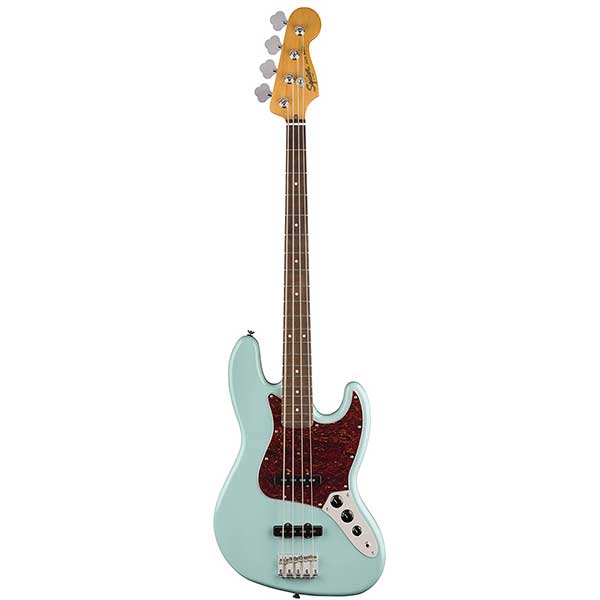
| Estimated Price | $400 |
| Scale | 34″ long scale |
| Finish | Gloss Polyurethane |
| Body material | Poplar |
| Neck | Maple with Tinted Gloss Urethane |
| Fretboard material | Indian Laurel with white dot Pearloid fret markers |
| Frets | 20, narrow, tall frets |
| Electronics | Passive |
| Control layout | 1 volume -neck, 1 volume-bridge, 1 passive cut only tone control |
My Review: Fender builds the most recognizable basses around and has been doing it for more than sixty years. The Jazz Bass is Fender’s most popular bass, and probably the most copied bass design there ever was. The Asian built Squier series was created to appease the masses demanding affordable alternatives of Fender’s mainstay instruments. Following an uptick of public interest for vintage instruments and the subsequent skyrocketing of their prices, Squier again met this challenge head-on, paying homage to legend by recreating the bass that had set the trend for decades after its inception: the 1960’s Jazz Bass, although with some minor modern tweaks to this iconic design. The Squier Classic Vibe ’60s Jazz Bass is the result of Fender’s labor, and what a great bass they’ve built! The “vibe” part of the name suggests that this is not a reissue of a 1960s era Jazz Bass, but that this is a modern instrument to which certain vintage features were added, to make it look, play, feel or sound in a manner that more closely resembles a Jazz Bass from 50 plus years in the past.
The body is crafted from solid poplar, possessing the same asymmetrical double-cutaway as it’s ’60s era counterpart, and every Jazz Bass ever since. The Classic Vibe Jazz Bass comes in 3 color alternatives: 3-color Sunburst, Daphne Blue, and Black, in a Gloss Polyurethane finish, all of them accompanied by the same 4-ply tortoiseshell pickguard.
The slender, C-shaped maple neck will feel instantly familiar to anyone who has ever laid their hands on a Jazz Bass. It is bolted on to the body using 4 screws and a neck plate with a Squier engraving. The fretboard is made from Indian Laurel and is adorned with white dot Pearloid fret markers and 20 tall/narrow frets. The headstock with its 4 vintage style, open-backed machine heads, is shaped in classic Jazz Bass fashion.
The hardware on all 3 color variants comes with a nickel finish, while the control knobs are made of black plastic. The L-shaped, vintage-style bridge with the threaded steel saddles feels appropriate for the general vibe of the instrument and offers adjustment options for intonation and string height.
The twin Fender-designed AlNiCo single-coils help deliver all the vibrant, harmonically rich tone you would expect from a Jazz Bass. The Vibe ’60s Jazz Bass obviously doesn’t have active electronics inside of it, however, it provides a 3 button control layout with 2 volume controls (one for each single-coil) and 1 passive tone control for rolling off the treble.
It comes with a decent factory setup straight out of the box, so you can start jamming right away without having to set it up yourself or taking it to a guitar tech. The quality of the finish and detailing isn’t as clean and precise as with non-budget-oriented Fender basses, if you take a closer look at your instrument you’ll start to spot these small imperfections, but at this price point, you can’t expect even as much attention to detail as they have already given to it.
If you are looking for a vibrant, rich, transparent tone from a Jazz Bass, this Squier model has all of that and much more. The Vibe ’60s Jazz sounds great even when unplugged, it resonates like a much more expensive instrument, there is lots of sustain and it has a surprisingly powerful voice whether you are playing with your fingers or a pick. Plug it into an amp and you’ll see for yourself what all the fuss is about. While there are many basses out there that have copied the Jazz Bass, with some even in the same price bracket, the classic Vibe ’60s Jazz Bass outclasses them all in terms of value, playability, and vintage sounding goodness. This a bass for the ages, a gem for beginners, and vintage bassists alike.
Related Article: Roundup of Our Favorite Acoustic Bass Guitars
8. Ibanez SR370E
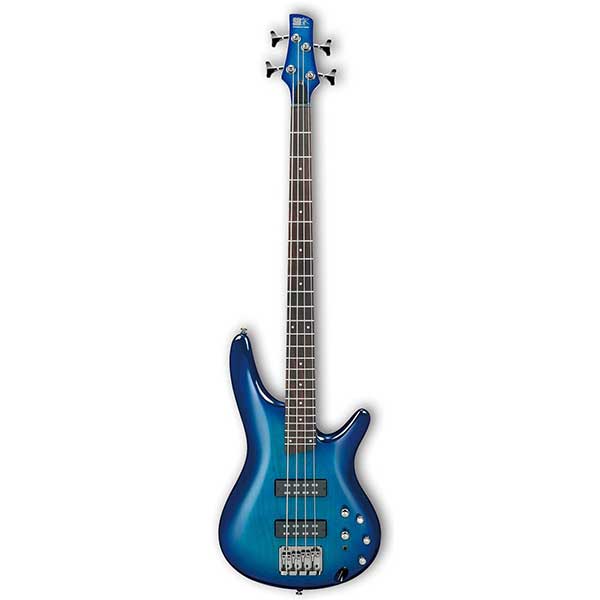
| Estimated Price | $400 |
| Scale | 34″ long scale |
| Finish | Maple |
| Neck | Bolt-on, 5-piece laminated Maple/Rosewood |
| Frets | 24, medium size |
| Electronics | Active, 3-band EQ, powered by a 9V block battery |
| Control layout | 1 master volume, 1 pickup blend, 3-band (individual controls for bass, mid and treble) with boost/cut + 3-way power tap switch |
My Review: Ibanez is one of the greats of guitar and bass manufacturing, with multiple decades of groundbreaking instrument designs under their belt. The SR line of basses has been around for more than 30 years now and will not be going away anytime soon. It features a broad spectrum of bass models, starting with the GSR series – oriented towards more modest budgets, up to the quite expensive basses of the SR Premium and SR Prestige series, offering exotic tonewoods and the highest quality of craftsmanship that Ibanez is capable of.
The cornerstones of the SR series, regardless of the price, are playability, versatility, and attention to detail. The SR370E truly shows its pedigree from the start. Like all basses of the SR line, it has the same flowing and organic looking body shape with a double-cutaway, the lower one, perfectly sculpted to enable you to comfortably reach up to the neck’s 24th medium-sized fret. The tonewood used for the body is maple, making for a solid bass guitar. It has the classic SR neck, famed for its slimness and speed, but in this particular case it features a laminated 5-piece maple/rosewood construction with a matte finish and fine Jatoba fretboard accented by white dot inlays, bolted on to the body in its very precisely routed pocket using 4 screws. It has a level of attention to detail you will not find on most basses in this price range.
The 370E comes in 2 color variations, Sapphire Blue and Natural Browned Burst with a matching headstock, both very pleasing to the eye. The hardware for both color variants comes in a dark grey finish Ibanez calls Cosmo Black and is typical of the SR series: sealed tuners on the headstock in a 2:2 layout and a chunky, well built B120 bridge enabling some of the easiest string changes and all the adjustments you could wish for.
The string spacing is set at 19mm which is standard on most basses. The SR370E features 2 PowerSpan dual coil humbucker pickups with exposed pole pieces. On the back of the body, you’ll find access to the electronics and the separate battery compartments, the latter supplying power to the active onboard 3-band preamp with a 3-way power tap switch. This switch enables you to select among 3 pickup configurations: Tap mode runs the humbuckers as single-coil pickups, series mode runs them as standard humbuckers and power tap mode combines a humbucker and a single-coil. The 5 knob control layout features a master volume, a pickup blend, and the 3-band EQ (each with its own control) that lets you cut or boost low, mid, and high frequencies by about 15dB and in combination with the coil tap switch adds a lot of versatility to an already very versatile instrument. SR series basses have always been known for their bright, open, and transparent tone, and the 370E is no exception to the rule.
This is a great bass for beginners and seasoned bass players alike. It’s packed with features, the build quality is excellent and the factory setup is spot on. It’s really a bargain for how good it sounds and for how much it brings to the table. It’s available in left-handed and a 5-string version called 375E with a slight price adjustment
9. Yamaha BB234
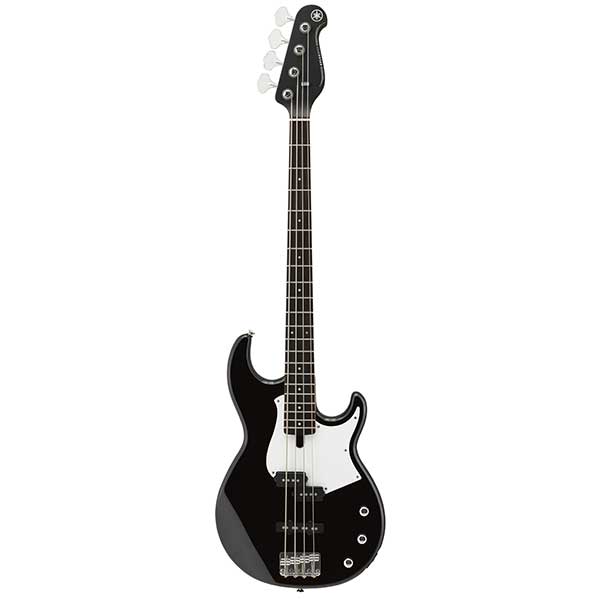
| Estimated Price | $300 |
| Scale | 34″ long scale |
| Finish | Gloss Urethane |
| Body material | Alder |
| Neck | Modern C-shape, Maple |
| Fretboard material | Rosewood |
| Frets | 22, Medium-sized frets |
| Electronics | Passive |
| Control layout | 1 neck pickup volume, 1 bridge pickup volume, 1 passive tone control with a cut only function |
My Review: Yamaha’s iconic line of BB (Broad Bass) bass guitars is more than 40 years old at this point in time. The first BB1200 rolled off of the assembly line in 1977. It was basically a high-end P-bass clone, featuring a neck-through-body design with a 5-piece laminated neck and a single split-coil P-style pickup with its cornerstones being superior sonic versatility and playability. Not long after the release of the BB1200, Yamaha realized the advantages of the P-J pickup combination and has arguably become one of the best P-J bass makers around.
The BB234 builds on this 40 plus year legacy by delivering the superb sound and build quality that this series is known for in a smaller body with even better playability geared towards new bass players. It features a very ergonomically contoured solid alder body with double cutaways and classic 1977 BroadBass styling. It comes in 4 color variants: Red with a white pickguard, Natural Satin with a black pickguard, Black with a white pickguard, and Vintage white with a black pickguard, all of them with a black headstock and gloss urethane finish.
The 34″ scale, bolt-on maple neck has a very fast, comfortable, modern C-shaped profile, a Rosewood fingerboard with 22 medium-sized frets, and is adorned with white dot inlays. The L-shaped, vintage-style bridge efficiently transfers the string vibrations to the body and lets you adjust the action and intonation.
The BB234 features Yamaha’s high output ceramic pickups, with a passive VSP3n P-style split single-coil in the neck position and a passive VSC3b J-style single-coil in the bridge position. This is a fully passive instrument and has a 3 control knob layout: 1 volume for the neck pickup, 1 volume for the bridge pickup, and passive tone control with only cut function.
The fortuitous combination of a solid alder body, slim bolt-on maple neck, and P-J pickup configuration is one recipe that Yamaha knows well. When you crank up the P-style neck pickup, you instantly get the classic percussive, low-mid heavy growl of a P-bass while dialing up the J-style bridge pickup will get you the punchy and transparent fingerstyle sounds the single-coil is known for. This bass is a no-frills powerhouse with a 40-year legacy and a modern twist, you can’t go wrong with it.
Popular Article: The Most Accurate Guitar Tuners Available
10. Jackson JS Series Spectra Bass JS3Q
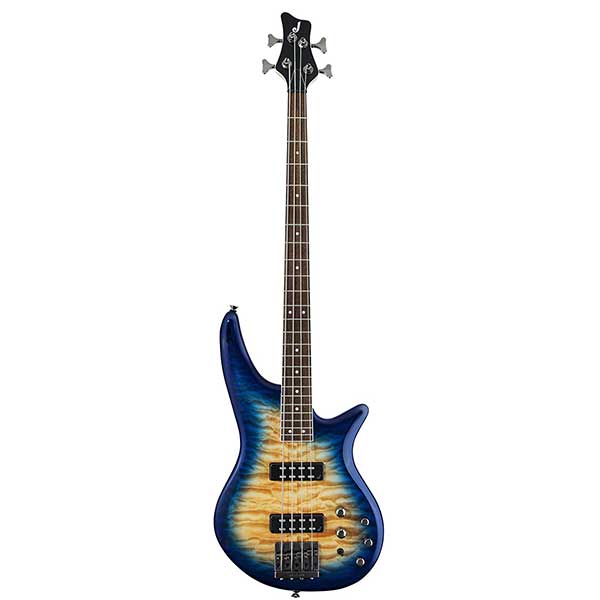
| Estimated Price | $350 |
| Scale | 34″ long scale |
| Finish | Glossy |
| Body material | Poplar |
| Neck | Maple, Bolt-on, modern C-shape |
| Fretboard material | Laurel with binding |
| Frets | 24, Jumbo-sized |
| Electronics | 9V battery-powered active onboard 3-band EQ with a 2-way coil tap switch |
| Control layout | 1 master volume (push/pull – active/passive), 1 pickup blend, 1 Bass,1 Mid, 1 Treble, 2-way coil tap switch. |
My Review: Jackson has more than 30 years of instrument building expertise under its belt and the Spectra JS3Q undoubtedly shows their mastery of this craft. The Jackson Spectra Bass JS3Q packs a lot of punch in a very aesthetically pleasing package, so if you’re looking for a great all-rounder bass guitar, this could very well be it.
It features a contoured poplar body, topped with an eye-popping quilted maple veneer, stained in an Amber Blue Burst, with a glossy finish. Its double-cutaway was designed with the comfort of the bass player in mind. The large upper horn keeps the bass well balanced while preventing neck dive and the lower one is much more restrained in its size, leaves enough space to allow you access to even the highest frets of the fingerboard.
The bolt-on neck is made from hard maple with a Laurel fretboard and is joined to the body through the use of 4 screws. Due to its compound-radius (heading up to the upper register of the instrument, the radius flattens out for easier runs and string bends) and smooth satin finish, this neck is very fast and is a joy to play on. Its 24 jumbo-sized frets are accented by simple white dot fret markers. The fretboard features a pleasing, well-executed white binding on its edges. The simple black headstock sports the same white binding as the fretboard, on it you’ll find the 4 Jackson sealed die-cast tuners in a 2:2 layout.
The recently upgraded Jackson HiMass bridge has plenty of heft behind it for it to properly transmit the string vibrations to the body making for a very resonant bass. It allows for the adjustment of intonation and string height. All the hardware on this bass comes in a black finish.
The JS3Q is equipped with twin passive Jackson Medium-Output Humbucking pickups, with exposed pole-pieces. It also has a 9V battery-powered, onboard active 3-band EQ which you can switch to passive mode through the push/pull volume control and as an extra cherry on top, a coil tap switch, not leaving much to be desired.
The Jackson Spectra Bass JS3Q is a unique instrument and hard to compete against in this price segment. It’s stunning looks aside, it really is feature-packed. From the active 3-band EQ, 2-way coil tap switch, the compound radius fretboard, to the very fast satin-finished neck, everything is designed to make you play and sound better. Hands down a great choice for beginners and veterans alike. If you’re looking for the best bass guitar for beginners this is definitely a top contender!
11. Dean Edge 2
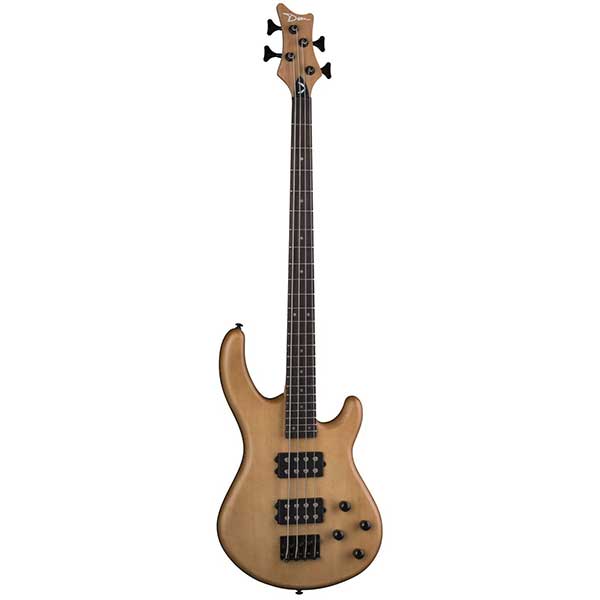
| Estimated Price | $250 |
| Scale | 34″ long scale |
| Finish | Vintage Natural |
| Body material | Basswood |
| Neck | Bolt-on, Maple, C-shape |
| Fretboard material | Rosewood |
| Frets | 24, medium-sized frets |
| Electronics | Passive |
| Control layout | 2 volume, 2 passive tone control with the cut only function |
My Review: The Edge 2 Electric Bass very much reflects Dean’s mentality and 20-plus years of experience in designing bass guitars. This is a straightforward, no bells and whistles workhorse bass, created to get the job done, be it practicing, or gigging.
It features a light basswood body, ergonomically contoured for very comfortable playing, whether hanging from a strap or resting on your leg. The generous lower cutaway lets you reach the highest frets on your neck with ease. It has a Vintage Natural finish that enhances the natural tone and grain of the solid basswood body and creates a pleasing subdued aesthetic.
The bolt-on, 34″ long scale maple neck has a modern C-shape and is profiled to be very fast when playing and with a sleek feeling to the touch. A custom-designed neck joint and heel along with an asymmetrical 4-bolt pattern ensure an impeccable transmission of vibration from the neck to the body greatly enhancing sustain and attack. The neck features a rosewood fretboard inlaid with 24 medium-sized frets and simple white pearl dot fret markers. The headstock has a matching veneer to the body and sports the 4 closed-back, die-cast tuners in a 2:2 layout.
The L-shaped, vintage style die-cast bridge efficiently transfers the string vibrations to the body and lets you adjust the action and intonation. The hardware comes in a black finish.
The Dean Edge 2 features twin DMT Design humbucker pickups with exposed pole pieces in the neck and bridge positions. They deliver fat and full-bodied low-end, percussive, and punchy mids with less high-end definition, that cuts through the thickest mix. Each of the two humbuckers has its own volume and passive tone control which allows you to mix and match as you please, offering a wealth of tonal versatility.
Related Article: The Most Comfortable Guitar Straps
12. Sire Marcus Miller P7 (2nd Gen)
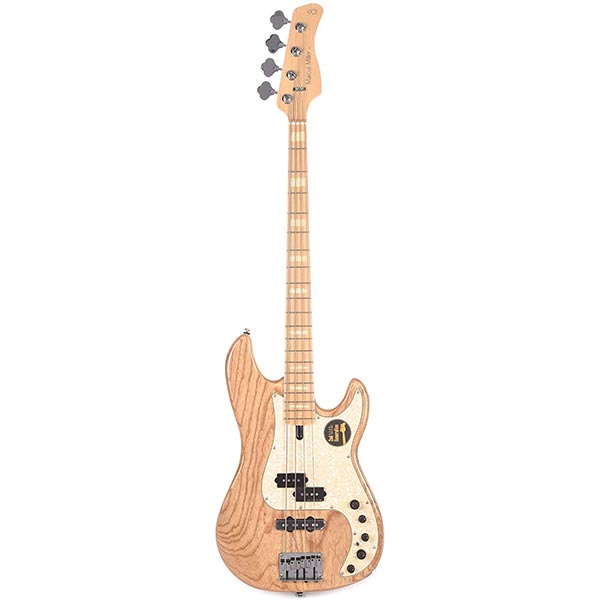
| Estimated Price | $670 |
| Scale | 34” |
| Finish | Natural Glossy finish |
| Body material | Swamp Ash |
| Neck | C-shape, Hard Maple (Satin Finish) |
| Fretboard material | Hard Maple, White Pearloid blocks |
| Frets | 24 Medium |
| Electronics | Active/Passive, 18V, Marcus Heritage 3 with Mid Freq control |
| Control layout | Volume/Tone, Pickup Blend, Treble, Middle/ Middle Frequency, Bass, Active-Passive Toggle Switch |
My Review: Sire is a newcomer among guitar manufacturers, first opening shop in 2015, and they have received only praise and rave reviews for their high-quality instruments at very affordable prices. By partnering up with bass legend Marcus Miller, and drawing upon his decades-long experience in the bass world, Sire has distilled the recipe of their instruments until they were left with pretty much what every bass player needs: great tone, great features, excellent playability, and an asking price that gives most other manufacturers a run for their money. In their line-up, you will find a good assortment of P-style, J-style, and as of recently, MM-style bases. The P7 (in its second iteration) is Sire’s take on the beloved Deluxe Precision Bass.
The P7’s body is modeled after the classic P-Bass, it feels solid and well balanced, just like it should. It’s made out of two solid pieces of premium Swamp Ash, expertly – and aesthetically – joined together. As is typical of Swamp Ash, the fundamental tone is thick and well-defined, with plenty of crystal clear highs, and percussive mids. The Sire P7 comes in three color options: Natural (transparent glossy finish), Tobacco Sunburst, and White Blonde (a slightly transparent white, that lets the patterned grain of the tonewood shine through). The P7 can also be had with a North American Alder body and the same color options except the Natural finish is switched for a glossy Black one.
The neck of the P7 is made from a solid piece of Hard Maple with a satin finish, and a hard maple fretboard featuring ‘70s style pearloid block inlays (the Alder body comes with an Ebony fretboard with the same inlays) with 24 medium-sized frets and a bone nut. The edges of the fretboard are pleasantly rounded for increased comfort. The neck sits in a precisely cut pocket and is fixed to the body using four bolts and a steel square plate. The back headstock is adorned with four quality open-geared tuners, in a Fender flavor, while on the front you’ll find the Marcus Miller logo – a testament to the P7’s inspiration. The neck is contoured with a thin C-shaped profile – very J-bass-like, making it very fast and comfortable to play.
The Marcus Miller Modern – S bridge of the P7 is also modeled after the classic Fender design, with its L-bracket shape, but this one is beefier, and the saddles have also been upgraded with more mass. It also features through-body stringing, for increased sustain and punch.
The P7 features a P-style pickup in the neck position and a J-style bridge pickup, they both feature AlNiCo rod magnets with exposed pole-pieces. They are paired with an active 3-band EQ with a sweepable midrange, running on an 18V circuit(two 9V batteries), while it can also function in fully passive mode.
The P7 is a delight to play, with the familiar neck-profile only improved by the rounded edges and the satin finish. Plugging it in you’ll be greeted by a powerful and precise bass tone with sparkling highs and well-defined midrange. The dual-pickup configuration delivers as promised: thumping P-bass tones aided by the classic, guttural, J-bass bridge tone. Mixing the two pickups gives you a wide assortment of good sounds, only aided by the versatile 3-band EQ. The midrange sweep lets you truly tailor your tone to your liking. It’s a rare and welcome feature, not found on most onboard preamps. The factory setup is excellent straight out of the box, with no further adjustments needed. The P7 is an excellent bass punching very high above its asking price.
13. Fender American Professional II Precision Bass
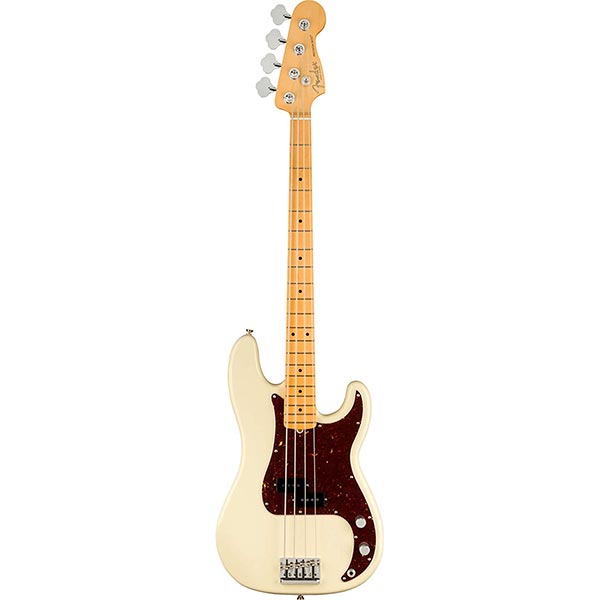
| Estimated Price | $1550 |
| Scale | 34” |
| Finish | White Glossy Urethane finish |
| Body material | Alder, Precision shape |
| Neck | 1963 C-shape, Maple |
| Fretboard material | Maple, Black Dots |
| Frets | 20, narrow-tall |
| Electronics | Passive |
| Control layout | Master Volume, Master Tone |
My Review: In 2016, Fender replaced the American Standard Series with the American Professional Series, featuring improvements following several years of player input. The American Professional II Series builds upon the already successful range by further tweaking and fine-tuning the design. All of the basses in the series are hand-built in Corona, California, and the line-up includes P-basses, J-basses in 4-strings, 5-strings, as well as fretless and left-handed models. The American Professional II Precision Bass is geared towards the working bass player, with premium build-quality and excellent sounds.
The body is cut to the classic Precision shape, with a double cutaway and a contoured neck heel enabling easy access to the upper registers. The use of Alder as a tonewood lends this bass a very well balanced tone, with good low-end content, crisp highs, and a lot of punch in the midrange.
The maple neck has a C-shaped profile and is crafted to 1963 Precision Bass specs but in contrast to the original, this model features graphite rods for neck reinforcement, resulting in a solid and extremely stable neck with improved sustain. It is secured to the body using five bolts and a steel neck plate bearing the Fender logo. The maple fretboard has rolled edges and features 20 narrow-tall frets with black dot fret-markers as well as a bone nut. The back of the neck has a satin finish, while the fretboard and headstock have a glossy urethane coating. On the headstock, you’ll find four lightweight, vintage-style, precision tuning machines with tapered shafts.
The bridge of the American Professional II Series is the second of the major updates to the line-up (the first being the graphite-reinforced neck), called 4-saddle HiMass Vintage, it brings more bulk to the table increasing sustain, as well as allowing for through-the-body stringing, further maximizing sustain.
The Vintage Mod II split single-coil Precision Bass pickup follows the classic recipe: AlNiCo rod magnets with exposed pole-pieces, but they are slightly overwound resulting in a hotter signal, with a more punchy tone and more growl. The electronics are fully passive, with a 2-knob control layout: a Master Volume and a Master Tone.
The American Professional II Precision Bass could be the best iteration of the P-bass that Fender has ever produced. Everything about this bass is just right: the neck is fast and comfortable to play, the graphite reinforcement gives it a rock-solid feel. Its tone is punchy and bright with a tight low-end, but when you dig into the strings, it growls like the best of them.
14. Fender American Professional II Jazz Bass
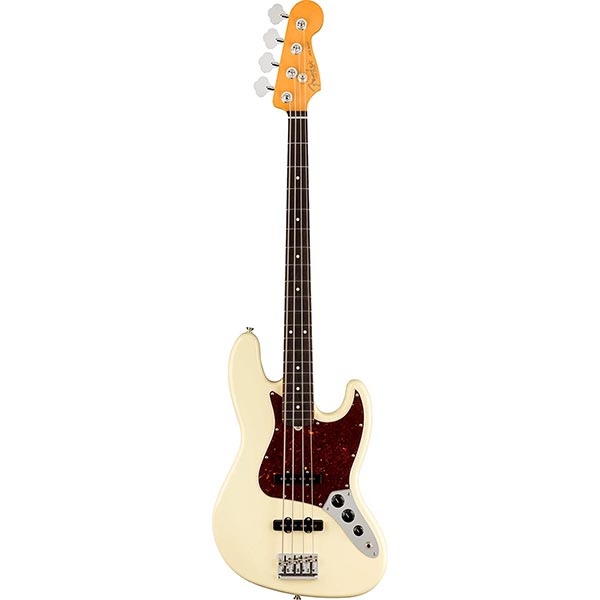
| Estimated Price | $1600 |
| Scale | 34” |
| Finish | White Glossy Urethane finish |
| Body material | Alder, Jazz Bass shape |
| Neck | Slim C, Maple |
| Fretboard material | Maple, Black Dots |
| Frets | 20, narrow-tall |
| Electronics | Passive |
| Control layout | Volume1 (neck), Volume2 (bridge), Master Tone |
My Review: The American Professional II Series continues Fender’s search for the ultimate bass guitar, this time focusing on their legendary Jazz Bass. The entire lineup aims to deliver the best instruments Fender can produce (excepting Custom Shop, of course), specifically crafted with the gigging musician in mind. These basses are hand-built in Corona, California to the highest tolerances. The Jazz Basses in the Series include 4- and 5-stringed variants, a fretless option, with a wide range of urethane finishes, and two fretboard wood options (Maple and Rosewood).
The body of the American Professional II Series Jazz Bass on hand is made from Alder; a good choice of tonewood, it resonates well and it produces a well-balanced Hi-Fi tone, especially with the Jazz Bass body style. The lows are tight and well defined, the highs are sparkly without being too harsh, and the mids are clear and percussive. There are a total of 8 color variants to choose from, all in a glossy urethane finish. You also have the option of selecting Roasted Pine as a tonewood, as a replacement for Swamp Ash, which Fender doesn’t offer any more for their regular production models.
The neck has a slim C profile cut from a solid piece of Maple and features a natural-feeling satin urethane finish. One of the important upgrades for the American Pro II Series is the reinforced neck that uses two graphite rods placed on either side of the truss rod; this modification improves the stability of the neck, as well as increasing the sustain and reducing the impact of dead spots. The fretboard is made from Maple (there’s also a Rosewood option), it has 20 nicely finished narrow-tall frets, ending towards the headstock with a bone nut. The fretboard edges are rolled (rounded) for increased playing comfort. The neck is bolted onto the body using 5 screws and a steel neckplate with an engraved Fender logo. The headstock is finished in glossy urethane, here you’ll find the four lightweight vintage-style open-backed machine heads.
The bridge has grown in mass when compared to previous generations, now it’s more akin to aftermarket hardware, and features the option to either top-load or through-the-body stringing. The saddles have also undergone an increase in mass, but the intonation and string height are still easily adjustable when needed.
The American Professional II Jazz Bass is equipped with two Vintage Modified II single-coil pickups with AlNiCo magnets and exposed pole-pieces, distinctly voiced for each position. They are slightly overwound producing a hotter output signal, enhancing the mids and the low-end while also decreasing the high-end. The electronics are purely passive, with the classic Jazz Bass layout: 2 Volume knobs (one for each pickup) and a Master Tone control.
The American Professional II Series Jazz Bass ticks all the right boxes, and Fender have outdone themselves. These are stage-ready basses straight out of the box. The factory settings are spot-on, the neck is very fast and comfortable to play, and not to mention rock-solid thanks to the graphite reinforcement. From a tonal standpoint, they offer exactly what you expect from a Jazz: the neck pickup sounds airy and thick with lots of low-end, while the bridge pickup is articulate and well-defined, and combining the two gives you everything in between. It’s definitely one of the best Jazz Basses around.
15. Ibanez Soundgear Premium SR1340B
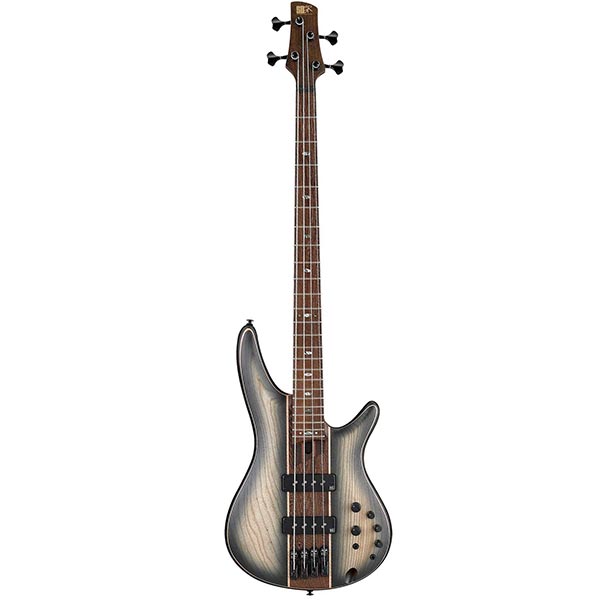
| Estimated Price | $1300 |
| Scale | 34” |
| Finish | Dual Shadow Burst Flat |
| Body material | Ash/Pangapanga top, African Mahogany body |
| Neck | Atlas-4, 5-piece Pangapanga/Purpleheart |
| Fretboard material | Pangapanga |
| Frets | 24, medium |
| Electronics | Active, 3-band EQ with 3-way mid-frequency switch |
| Control layout | Master Volume, Pickup Blend, Bass, Mid, Treble, 3-way mid-frequency switch, Active/Passive switch |
My Review: Soundgear basses are well known for their excellent playability, good build quality, and great tones at affordable prices. But for the more demanding bass players, Ibanez has created the Prestige and Premium series of basses. In 2020 they’ve expanded their Premium line of Soundgear (SR) basses with the addition of the 1600 and 1340 models. The only difference between them being the tops used. Here we will be focusing on the Premium 1340B.
The Body of the 1340B is typical for the SR line: an ergonomically sculpted double-cutaway design with an oversized top horn. It is made from African Mahogany, but the top is something special: it features a Pangapanga center with Ash sides, masterfully bound with maple in a Dual Shadow Burst satin finish.
The 5-piece Pangapanga/Purpleheart neck is built with a flat D profile and uses titanium rods as reinforcement, for increased stability and sustain. The fretboard is home to 24 well-finished medium frets with Abalone oval inlays and is also made from bound Pangapanga. The neck is bolted on to the body with 4 recessed screws and sits in a precisely cut neck heel.
The MR5S bridge employed in the 1340B uses individual rails for each string, enabling precise adjustment of string height and intonation as well as an adjustable string spacing by as much as 1.5mm.
The 1340B has a pair of Nordstrand Big Single pickups creating its exquisite tone. These are specially designed single-coils housed in soapbar-sized enclosures. They sound bright, punchy, and articulate, and although they are not noise-canceling, there is virtually no hum coming from them. The 1340B has a powerful and versatile active 3-band EQ with a boost/cut function. There’s also a selectable 3-way mid-frequency switch that lets you choose a center frequency for the midrange – a rare occurrence for any onboard preamp.
The 1340B Premium fully delivers on its promise of high-end build-quality and sounds. The bass is stunning to look at but its tonal range is even more impressive. The already renowned Big Single pickups offer more output than your average J-style pickups, but they never get muddy and are always well-behaved in their lows and mids. The EQ is excellent, giving you access to a wide range of sounds one does not usually associate with the SR line: from metal to funk or jazz, the SR 1340B does it all.
16. Washburn Taurus T24NMK
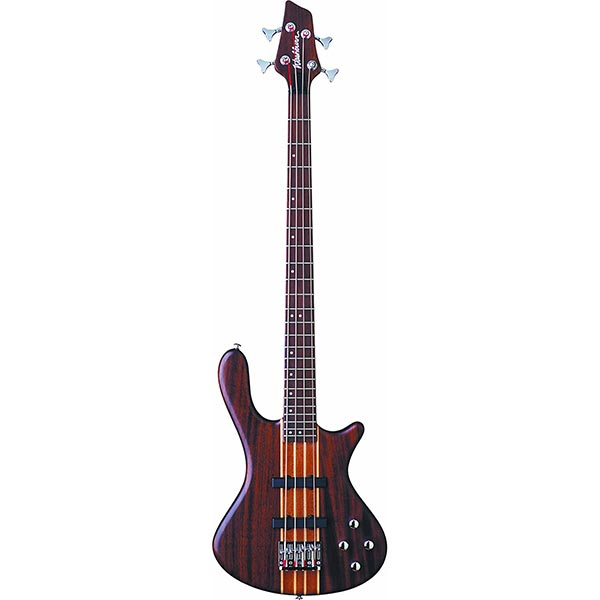
| Estimated Price | $650 |
| Scale | 34” |
| Finish | Natural Matte |
| Body material | Mahogany |
| Neck | 5-piece Mahogany/Maple |
| Fretboard material | Ebony, offset dots |
| Frets | 24, medium |
| Electronics | Passive |
| Control layout | 2xVolume, 2xTone |
My Review: Washburn is not usually one of the top contenders when talking about basses, and that really is a pity, because they make good-quality instruments at very affordable prices (mostly electric guitars). Their bass offering currently includes three models: a J-style bass, a P-style bass, and the Taurus – which is something special altogether.
The Taurus has a distinctive body shape, with a double-cutaway design, a massive top horn, a diminutive lower horn, and ergonomically shaped contours – reminiscent of Warwick basses. It uses Mahogany as a tonewood, that is laminated with Maple and comes with a natural matte finish. One distinguishing feature of the Taurus is that it boasts a neck-through-body design – virtually unheard of in its price range. This will give the Taurus much more sustain than its bolt-on counterparts, but it will also slightly reduce the attack.
The 5-piece neck has a flat D-shaped profile and is built out of Mahogany laminated with strips of Maple. The fretboard features 24 medium-sized frets with offset pearloid dot markers and is made out of Ebony.
The bridge of the Taurus is made from a hefty piece of stainless steel and offers the usual adjustments for intonation and string height.
The Taurus employs a couple of Washburn designed J-style single-coil pickups, that have been overwound for an increased output voltage. They sound a bit darker than your typical J-bass pickup, probably due to the overwound coils, but the lows and mids are still well-defined with slightly subdued highs. The Taurus is a fully passive instrument, with a simple 4-knob control layout: 2 Volume knobs and 2 Tone knobs.
Washburn has clearly produced an instrument that punches well above its asking price. The neck-through construction brings loads of sustain to the table. The single-coils and Mahogany body are a fortuitous combination offering a darker but still well-balanced tone that would fit in with any style of music. The Taurus is a great bass with good build quality and good sounds. It’s a prime candidate for a pickup and/or electronics upgrade, but with those, it could easily go toe to toe with instruments three times more expensive.
17. Sterling by MusicMan Stingray Ray34HH
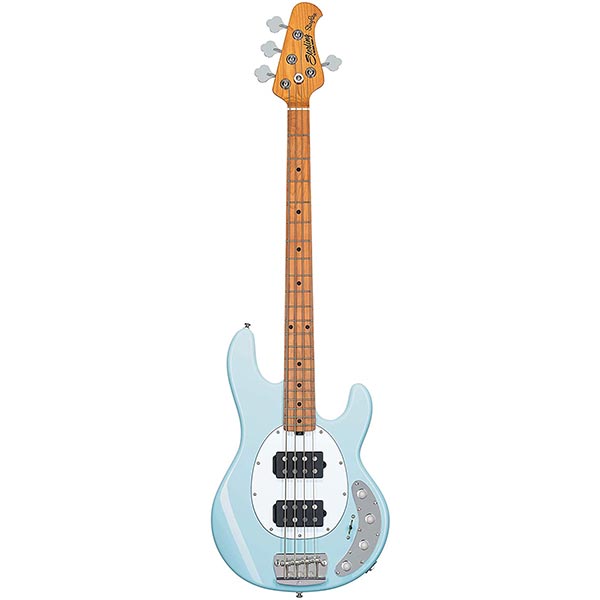
| Estimated Price | $900 |
| Scale | 34” |
| Finish | High Gloss polyester, Daphne Blue |
| Body material | Mahogany |
| Neck | Roasted Hard Maple |
| Fretboard material | Roasted Hard Maple, black dot markers |
| Frets | 21, wide-high profile |
| Electronics | Active, 3-band EQ with 5-way pickup selector switch |
| Control layout | Master Volume, Treble, Mid, Bass |
My Review: The Sterling line by MusicMan has long been tasked with producing affordable copies of the legendary Stingray basses by using cheaper components, and less precise build quality, but with this iteration that line of thought has gone out the window. The materials used are basically the same as with the US-built basses, and except for the Sterling logo, you wouldn’t know the difference from a “real” Stingray double buck.
The body of the Ray34HH follows the contours of the original, it is built from Mahogany and finished with a glossy polyester coating over a “Daphne Blue” base – it looks stunning.
The neck borrows the roasted Hard Maple construction from its premium-priced brethren, with a roasted Hard maple fretboard adorned with 21 wide, high-profile frets and black dot fret markers. The neck sits snugly in a precisely cut heel and is bolted to the body using 6 stainless steel screws and a steel neck-plate engraved with the Sterling logo. On the headstock, you’ll find four Schaller BM, lightweight machine tuners with tapered string posts.
The Ray34HH houses two Standard Music Man Humbuckers with AlNiCo ceramic magnets and exposed, oversized pole-pieces. It has an active preamp – as is standard for MM basses – with a 3-band EQ. The 5-way pickup selector switch lets you choose the way the pickups operate, whether humbucking or single-coil.
The Ray34HH’s Music Man chrome-plated bridge is built out of hardened steel and is equipped with stainless steel saddles that enable the standard adjustments for intonation and string height.
The Sterling Ray34HH gives you everything you expect from a USA-made Stingray but at a fraction of the cost. The tones are there, the playability is there, and the quality woods and components are there. Earlier versions of the Sterling Ray34 were always lacking something, but this one has it all, and it gives its more expensive siblings a run for their money.
Choosing the Best Bass Guitar for Beginners (Buying Guide)
Buying a bass guitar is a daunting task, especially when it’s your first one. Never in the history of Bass have there been so many options to choose from, new manufacturers are popping up all the time while established brands offer better and better instruments with more features and at lower prices than ever before. It’s a great time to be a bass player, but an even greater time for choosing your first bass.
In this guide, we’ll be going through some of the basics and some more advanced features and concepts of bass guitars so that at the end of it you’ll be able to choose the best instrument that suits your needs.
There are a few things you should know and a few questions you should ask yourself before going and impulsively buying the first ax you like the shape or the color of.
Anatomy of a Bass Guitar
The Headstock: It’s the part at the end of the neck, this is where your tuning keys are located and where most manufacturers put their logos.
The Neck: It’s the part of the bass you play notes on, it is bolted or glued to the body, on it you’ll find the fretboard with its frets, dot markers, and the truss rod nut for adjusting the tension and relief of the neck
The Nut: This is where the strings rest at the base of the headstock, the material it is made of (bone, plastic, or metal) affect how the string vibrations pass on to the neck and through it, to the body. Different materials will lead to subtle differences in tone
The Fretboard: This is where frets and the dot markers are located, it is commonly made out of some type of hardwood (Ebony, Rosewood, or Maple are staples) the type of material influences the tone of your bass.
The Frets: These are the metal wires that are inserted into the fretboard, each fret represents a musical note, their number varies – it’s usually between 20 and 24 (2 octaves per string)
The Body: This is the main part of the bass, it’s usually made out of one or more solid pieces of wood glued together, on it you’ll find the pickups (or a single pickup in some cases), the neck joint, and heel (where the neck meets the body), the bridge (where the strings are anchored and adjusted), various control knobs (1 or 2 volume knobs and tone control are standard) and the input jack (where you plug in your guitar cable). On the back of the body, you will find access to the electronics compartment housing all the pots and electronics, though sometimes it is located under the pickguard on the front of the instrument.
The Pickups: These sit under the strings and convert their vibrations into an electrical signal that will be sent to your amp through the guitar cable to be amplified.
The Bridge: Sometimes called the tailpiece, this is the solid piece of metal where the strings are anchored and adjusted for height, intonation, and sometimes string spacing
Knowing what you want:
What music do you like to listen to?
Are there any bass players you like?
Is there a specific bass sound you would like to emulate?
As an example, Motown legend James Jamerson had a vastly different setup and approach to the bass guitar than Robert Trujillo of Metallica has. Answering some of these questions will help nudge you in the right direction when looking for your first or next bass.
Knowing what you have:
Setting a budget for your bass is important. It will help you to narrow down the list from the hundreds of options you have.
At what point are you in learning to play bass? If you are just starting with the bass, maybe stay clear of fretless or extended-range basses like 5 and 6-strings. These have steeper learning curves in mastering them than a standard fretted 4-string bass and could potentially make your progress slow, frustrating, or both.
Knowing what you need:
A good first bass should be light and comfortable as it will probably be hanging from your shoulder for hundreds of hours. It must be easy to play, have a great tone, and as you perfect your technique, it should meet your bass needs without hindering your progress.
What style of music do you want to play?
Some basses are tailored for every style of music, and while a good instrument will do a fine job in any situation, there certainly are some that make your life easier than others. For example, if you play metal you would probably be better served by picking a bass with a 35″ scale length (making drop tunings tighter) than with a 34″ scale bass like a Fender Jazz. That is not to say that you can’t do it with a good old Jazz Bass. Just that some tools are better suited for certain tasks, and knowing what that task is will help you choose the right bass for your needs.
How many strings do you need?
Most bass guitars you will encounter will have 4 strings (E, A, D, G). This is the standard among bass players, and you could play your whole life without laying your hands on an extended range bass (5-string or 6-string), – many bass legends never did. If you are new to the instrument, you should probably start with a 4-stringed bass.
A 5-string bass (usually B-E-A-D-G) adds a layer of complexity with the “low B” string below the E string on a standard bass. A 6-string (B-E-A-D-G-C) adds the “high C” string above the G-string. The evolution of metal and rock has made a “low B” commonplace, but you can make do with restringing a 4-string bass with a B-E-A-D. This will keep things easy as you don’t need to adjust your playing technique to an extra string while giving access to the low register of the B string.
The takeaway here is: If you are starting newly, just skip the extended range basses for now. If you play in a band where a low B is mandatory, you can easily restring your 4-string bass.
Scale Length Explained
Scale length refers to the distance from the nut of the neck to the bridge and determines how long the neck of the bass is. It influences how your bass sounds, handles and feels to play. The standard scale length for an electric bass guitar is 34″ and is called “long scale”, this is the scale length of the Fender Precision and Jazz basses. 30″ or less is called “short scale” like Paul McCartney’s violin bass, 30″-33″ is called medium scale length and the extra-long scale which is 35″ or above in length.
Short scale basses will have softer and more melodic sounding mid-tones than a standard 34″ scale bass, while an extra-long scale bass will have tighter lows and punchier mids. This is why many metal bass players prefer extra long scale basses. Another thing to consider is the fact that as you increase the scale length of the bass, you will also increase the overall weight of the instrument. Longer necks require heavier bodies to balance them out. Short and medium scale basses are a great option for children or short people because of the shorter neck and lighter bodies.
A shorter neck also means that the spacing from fret to fret is also smaller, so small hands don’t have to stretch as much when playing. Don’t worry too much about the size of your hands, as you’ll learn to adapt to any scale length as many others have before you.
Bottom line: If you have small hands or require the harmonically richer sound of the shorter scale lengths, take a look at the short/medium scale offering. Bear in mind that a child won’t have small hands forever. If you want to play metal, extra long scale basses could be your best bet.
Fretted vs Fretless Bass
Standard bass guitars will have metal frets inserted into the fingerboard to mark the exact spot where a particular note will ring true (fretted bass). This is opposed to a violin or double bass, where you need to know where to place your finger to produce the same note. A fretless bass is the same as a fretted one, but with all the frets removed. Playing fretless is not recommended for someone just starting with the bass guitar, so if you are a beginner, just get a standard fretted bass – you’ll be grateful you did this in the long run.
Body Woods Explained
The type of wood that a bass guitar is made of will greatly influence its sound. Harder woods will produce a more acute, percussive sound with more sustenance while softer woods will sound warmer and mellower. Hardwoods used in building bass guitars include Ebony, Rosewood, Hard, Rock, or Maple. These are commonly used for fretboards, while Walnut, Mahogany, Wenge, Koa, and Bubinga are some that are used for the bodies. Softer woods that are used as resonance woods for bass bodies include Alder, Swamp Ash, and Basswood.
Alder is one of the most frequently used in bass construction because of its well-balanced sound, offering well-defined lows, punchy mids, and clear highs.
Swamp Ash will have less punchy mids and a more pronounced high end than Alder but will still have a strong low end and sound transparent and sweet.
Basswood is used for more budget-friendly basses, but the sound it produces is warm and transparent.
Mahogany stands somewhere between the hard and soft tonewoods. It is widely used in electric bass and guitar bodies and delivers a darker sound, having a well-balanced tone with less pronounced highs than softer woods.
The type of wood the fretboard is made of will also influence the tone of the bass. The most common fretboard woods are Rosewood, Ebony, and Maple; Rosewood being by far the most common of the three.
Rosewood fretboards have a mellower sound to them, evening out harsher high frequencies, and will imbue your bass with a warm and rich tone.
Ebony has been used for centuries to make fretboards for classical instruments like cellos and violins. An Ebony fretboard sounds bright and crisp, with great attack and excellent sustain.
A Maple fretboard will have a bright tone (comparable but not as bright as Ebony) and well-defined lows with a good punch and decent sustain.
Neck Types Explained
How the neck and body of a bass guitar are joined will influence the way the instrument resonates and therefore influence its tonal characteristics. In the Bass world, there are 3 common types of neck joints; these are the bolt-on, the set neck, and the neck-through design.
The most used type of neck joint is the Bolt-on neck. As the name suggests the neck is bolted onto the body using screws or bolts. Basses with bolt-on necks are not as labor-intensive and time-consuming to build as the other two designs. Because of this fact, most entry-level basses use the bolt-on neck joint. However, this does not mean it is inferior in any way to the other types. A bolt-on will have the fastest attack but not as much sustain as a set-neck or neck-through design. Many bass players who like to ‘slap’ use basses with bolt-on necks because of their fast attack sustain being secondary with this technique. Also, all Fender basses have bolt-on necks, and there’s nothing more iconic than a P-bass.
With the set-neck which is also called a dovetail, a pocket is cut into the body and the neck is glued inside. This type of neck joint requires more skill from the luthier than a bolt-on neck and is generally found on more premium-priced basses. It is the common ground between the bolt-on and neck-through designs, having a fast attack (not as fast as the bolt-on), and improved sustain (not as much as a neck-through).
The neck-through type of neck joint is found on the higher end of the price range for a bass guitar. The neck will run through the entirety of the bass, while the “body” is then glued directly to the sides of the neck. A neck-through bass will have a strong low end, slower attack compared to a bolt-on neck, but will have sustain for ages. This design is preferred by players who like to solo because of the “piano string” like the quality of the tone.
Pickups Explained
The pickups in an electric guitar or bass convert the vibrations of the strings into a signal that will be sent to your amp to – go figure – be amplified. Therefore they have a great influence on your tone and you will need to choose wisely as every pickup type has its advantages and disadvantages.
There are 3 basic pickup designs that you’ll encounter on most basses: the single-coil, the humbucker or double coil, and the split coil.
The single-coil pickup has a single coil wrapped around the magnet inside the housing. The sound they produce is bright and punchy. But there is a problem with single-coil pickups as with a Fender Jazz Bass, they will pick up noise or “hum” from anything (computers, fluorescent lighting, radio waves) when the volumes are not the same on both pickups. To avoid this humming, the humbucker and split-coil were created.
The humbucker is a double coil pickup; basically, two single-coil pickups glued together and out of phase with each other to cancel out that hum the single-coils are known for. They sound generally darker and less bright than single-coils but have greater output. This pickup design can be found on MusicMan basses and many others.
The split-coil design, as on a Fender Precision Bass, is basically a double coil pickup, but it is split into 2 halves, with each half of the double coil sitting under 2 of the bass strings. This design delivers a sound characterized by fat lows and punchy mids, but less high-end sparkle than single-coil or humbucker pickups.
Electronics: Active vs. Passive
In the early days of the electric bass, you had very few options to shape the tone coming out of your guitar. You either mixed the volumes of your pickups in different ratios or you used the tone control knob which only lets you cut high frequencies. This lack of tonal versatility present in passive basses has pushed bass players searching for more control over their sound to adopt active onboard electronics.
An active bass is usually a standard bass with passive pickups but it will be equipped with an active – battery-powered – preamp running on a 9V block battery or sometimes two of them (18V – with better fidelity and headroom). Most active onboard preamps let you tweak your sound with a 2 or 3-band EQ with boost or cut function. In addition to greater versatility and tonal control, active basses are less prone to introduce noise or interference and will deliver a hotter signal with less degradation than a passive bass. NOTE: If you leave your cable plugged into your bass it will drain the battery, so either unplug your bass or switch it to passive mode (most preamps let you do this).
Hardware Considerations
The hardware on a bass has two sonically significant components, the tuning keys, and the bridge. The tuning keys come in two basic varieties: sealed and open-backed, the difference between them being that open-backed tuners need to be cleaned and oiled once in a while. The bridge or tailpiece is a very important component of your bass. It’s where the strings attach to the body and through it. The vibrating strings will resonate the tonewood of the instrument and thus, shape your tone. A good bridge must have some mass behind it so that it will transmit the string vibrations properly. This is one of the most frequently upgraded parts on Fender basses, as their standard L- shaped bridges are some of the thinnest you’ll see on a bass guitar and they only have the most basic adjustment options. Each string will be placed in an individual saddle, allowing for the adjustment of string height, intonation, and, with more complex bridge designs, the string spacing.
Body Shape/Contour
The shape of the body has less to do with the sound of the bass, and more to do with the playability, aesthetics, and how comfortable it is while hanging from your shoulder. Electric basses usually abide by a standard double-cutaway design, meaning they have 2 horns above and below the neck. On the upper horn which is usually larger in size, you’ll find one of the two strap buttons (the second strap button is usually found near the bridge) used to attach the strap. The smaller horn or cutaway is the important one, depending on its size and shape it will be easier or harder to comfortably play in the higher registers of the neck. A good-sized bottom cutaway with rounded edges is preferred. The heel of the bass is where the neck meets the body and a well-contoured, ergonomically shaped heel will also allow easier access higher up the neck.
If you’re looking for the best beginner bass guitar, look no further! Over the years, we have tested dozens of bass guitars and compiled a list of our favorites here.

My name is Chris and I’ve had a passion for music and guitars for as long as I can remember. I started this website with some of my friends who are musicians, music teachers, gear heads, and music enthusiasts so we could provide high-quality guitar and music-related content.
I’ve been playing guitar since I was 13 years old and am an avid collector. Amps, pedals, guitars, bass, drums, microphones, studio, and recording gear, I love it all.
I was born and raised in Western Pennsylvania. My background is in Electrical Engineering, earning a Bachelor’s degree from Youngstown State University. With my engineering experience, I’ve developed as a designer of guitar amplifiers and effects. A true passion of mine, I’ve designed, built, and repaired a wide range of guitar amps and electronics. Here at the Guitar Lobby, our aim is to share our passion for Music and gear with the rest of the music community.
